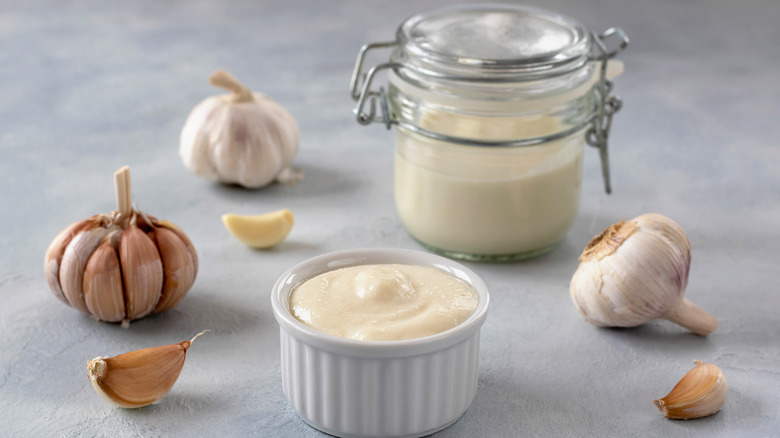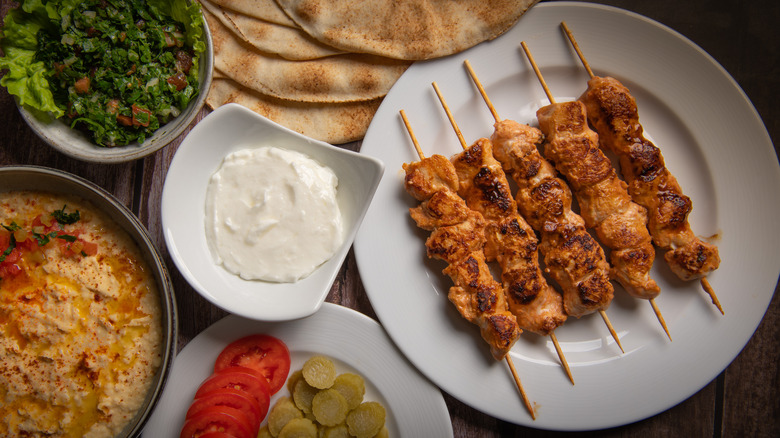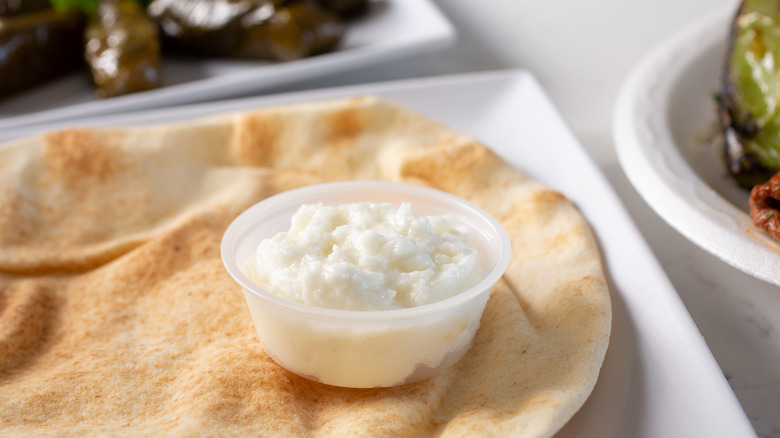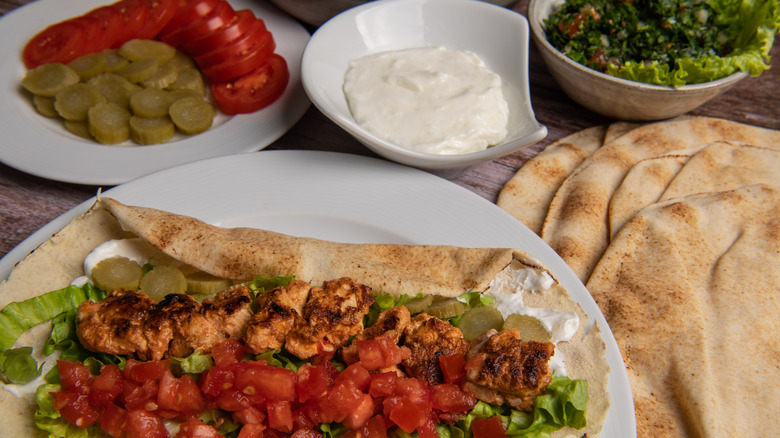Lebanese Toum Is The Garlic Sauce You Should Know
Emulsions are a delicate type of sauce-making. Made up of tiny fat molecules distributed through a liquid, they're not naturally very stable. However, when delicately balanced, their creamy texture is mouthwatering — think a perfectly executed hollandaise.
In Lebanon, a delicious emulsion called toum comes together with garlic. The sauce only incorporates five ingredients — lemon juice, olive oil, water, salt, and garlic. However, it's deceivingly difficult to mix, often falling apart into a liquid pulp. Once perfectly executed, it yields a tantalizing creamy texture.
Toum showcases the best attributes of garlic in an easy-to-use format. Tangy, savory and earthy, it makes the root vegetable more palatable without dialing down its intensity. Plus, it's wondrously versatile. Utilized as a topping atop a kebab and salad or integrated as a base into a soup, it adds an irreplaceable component. No surprise it's become an iconic table-side condiment. Let's dive into how it came about.
Toum is a centuries old Lebanese staple
Toum's exact origins are unknown; however, it's been prepared in Lebanon for several centuries. The name hails from Arabic, translating to garlic. Such a nomenclature showcases the sauce's malleable character — a multitude of variations exist throughout Lebanon as well as the Middle East. In Lebanon, specifically, the city of Zagarta is noted for its rendition of toum with mint. And in Egypt, a nearly identical garlic condiment is called Tooma. Other similar sauces are prepared elsewhere throughout the Mediterranean, too, including Greece and Italy.
Today, toum is often crafted by hand on Sundays, with recipes passed down through generations. It's both an everyday staple, and a revered condiment — integrated as a base for delicious Lebanese soups, sauces, and marinades. Toum requires both patience and a careful technique to ground and emulsify. Such a labor-intensive preparation lends it an esteemed reputation, especially when prepared well.
Making toum is similar to aioli
Toum is an emulsion reminiscent of aioli. However, instead of utilizing egg as a binder, it employs exclusively garlic. As a result, it's less stable but can still yield a delectable creamy texture when combined properly. Plus, it's vegan — incorporating garlic, salt, lemon juice, water, and olive oil.
The condiment starts by prepping the garlic. The cloves are peeled and split in half. The germ is removed, as are stale bits of the plant. Utilizing the freshest garlic available is paramount; the quality corresponds to taste. Traditionally, the cloves are laboriously pounded in a mortar and pestle. Once a paste-like mixture forms, a drizzle of lemon juice is added. Then, olive oil, and water are meticulously mixed in until it turns creamy. With a sprinkle of salt, the toum is complete.
In modern times, toum is also prepared in a food processor. The use of tech eases manual labor but makes the sauce more prone to not emulsifying. After the garlic and salt go through an initial pulverization, the lemon juice is introduced. Once thoroughly homogenous, the olive oil is poured; crucially very slowly. Slow drizzles are briefly interrupted with dashes of lemon juice and water to stabilize. With attentive care, the sauce achieves its delectable creamy texture. It'll store refrigerated for a month.
How is toum served?
Toum functions wondrously as an aromatic base, enabling an easy-to-integrate garlic flavor into a variety of dishes. It can be used as a marinade for chicken and seafood, drizzled onto roasted vegetables, or thrown onto a salad. In Lebanon, it's often served as a table-side condiment, spooned onto everything from fries to grilled meats and salad. It's especially popular alongside barbecued ribs and grilled chicken, adding an earthy element when dolloped onto a pita. And toum is the go-to topping for Kibbeh, a bulgur-based dumpling filled with meat.
Since toum has a direct garlic flavor, it's easy to integrate for cuisines outside the Levant, too. Utilize the sauce in a pizza base or as a component of a tomato basil soup. Throw it onto pasta or a platter of potatoes. It's handy to keep a pre-prepped batch in the fridge — toum is easier to integrate into foods than raw garlic.



